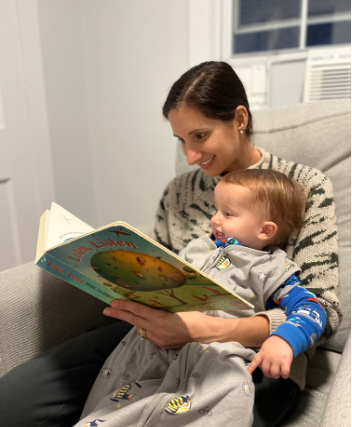Caryn reading to her son Julian
By Caryn Leahy, Vice President
As the mom of a toddler, I spend a lot of time reading children’s books. But that doesn’t mean I’m not learning. Eighteen months into reading to my kiddo each night, I’ve observed that material meant for little humans can teach us adults just as much – if not more – about the art of communications. Here are my top six takeaways from the children’s book genre:
- There’s no such thing as too much message repetition…as long as your message is pithy and tailored. We’ve all heard it before; repetition matters when it comes to message conversion. And there’s a reason classics like Brown Bear hit you over the head with the same phrases again and again and again. It works. But only because the message is tight and interesting to its small-bodied target audience. If you fear you’re overdelivering a (well-written/well-tailored) message – keep going.
- Stories, not statements. One of my favorite pieces of kid lit is Suzanne Lang’s Grumpy Monkey. GM offers a refreshing take on mental health, helping kids understand that it’s okay to make space for uncomfortable feelings. But instead of simply – and ineffectively – telling our babes that they should express themselves freely, the story is endearingly told through the eyes of Jim Panzee (aka “Grumpy Monkey”) and his gorilla buddy Norman in which *spoiler alert* they both discover that the key to feeling better is to openly acknowledge one another when they’re having a bad day. Stories are sticky, statements are not.
- Tap into the senses. Many children’s books help kids access the five basic senses. That’s because sensory experiences stick with us in a way words alone don’t. Currently, Julian and I are loving Listen, Listen by Phillis Gershator and Alison Jay, which takes us through the sights, sounds, tactile feelings, tastes, and smells of each season. It’s a delight for child and caretaker alike.
- Visuals first, then text. I’m convinced that the reason a picture is worth a thousand words is because we’re all one-year-olds at heart. Just as Goodnight Moon would be nothing (nonsense, really) without its unique use of color and the contrast between the brilliance of the moon and the dullness of the room, complex issues and ideas are often meaningless without visuals that bring those ideas to life. In fact, compared to text alone, text paired with images has been shown to improve comprehension by up to 89%.
- Short-form is king. There’s a time and place for long-form pieces; communicating with toddlers is not one of them. But the reality is that most of us have limited attention spans – and they’re narrowing now that we have more things to focus on and distract us than ever before. Keeping your communications tight through short-form content, TL;DRs, and smart brevity of the Axios persuasion will go a long way.
- Consider your extended audience. When Julian was first born, a friend mailed us some books that he said were sure to be hits in our family, not because our newborn who could barely see nor hear would appreciate them, but because we, his parents, would. With titles like Dragons Love Tacos and The Day The Crayons Quit, these were not classics, but their authors were on to something that will make them classics someday. Sometimes speaking to the people your target audience cares about most (their parents/caretakers in this case) is just as – if not more – powerful than speaking to your audience directly. After all, what is most likely to move those you’re trying to reach is what will move their loved ones.

